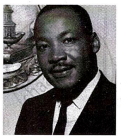Advertisements
Advertisements
Question
Why was there a significant change in the US Government’s attitude towards racial discrimination with the appointment of the Truman committee (1946)?
Solution
Harry Truman is a name usually associated with America’s Civil Rights movement. The main ‘points’ that happened after his presidency were Montgomery, Little Rock, Birmingham, the careers of Martin Luther King and Stokely Carmichael. However, some very important civil rights issues were covered ‘ in his presidency. In 1946, Truman did establish a civil rights committee whose task was to examine violence against African Americans within America itself. This committee was filled with known liberals who Truman knew would produce a report that would and should shock mainstream America. The report was issued in October 1947.
The report was called “To Secure These Rights”. It was highly critical of a nation that appeared to tolerate the way African Americans were treated at a time that the nation also claimed to be the world’s leading light of democracy and protecting the world against the evils of communism, which destroyed the individual rights of the people under the tyranny of Communist Governments. The report wanted the Federal Government to use its authority to end segregation in America and lynching to be made a federal offense. The poll tax abolished voting rights introduced for African Americans which guaranteed their right to vote in elections free from threats of violence.
The FEPC made a permanent feature in America to end discrimination in inter-state traveling to end discrimination in the armed forces. The powerful Justice Department in Washington has a permanent Civil Rights section for Government financial backing for lawsuits to be taken by African Americans or others in favor of civil rights; when heard in a federal court for the creation of the United States Commission on Civil Rights.
During less than 13 years of Dr. Martin Luther King, Jr.’s leadership of the modem American Civil Rights Movement, from December 1955 until April 4, 1968, African Americans achieved more genuine progress towards racial equality in America than the previous 350 years had produced. Dr. King is widely regarded as America’s pre-eminent advocate of non-violence and one of the greatest nonviolent leaders in world history.
Drawing inspiration from both, his Christian faith and the peaceful teachings of Mahatma Gandhi, Dr. King led a non-violent movement in the late 1950s and ’60s to achieve legal equality for African-Americans in the United States.
His contributions are manifold :
In 1955, he was recruited to serve as spokesman for the Montgomery Bus Boycott, which was a campaign by the African- American population of Montgomery, Alabama to force integration of the city’s bus lines. After 381 days of nearly universal participation by citizens of the black community, many of them had to walk miles to work each day. As a result, the U.S. Supreme Court ruled that racial segregation in transportation was unconstitutional.
In 1957, Dr. King was elected as the Conference (SCLC), an organization designed to provide new leadership for the now burgeoning civil rights movement.
In 1963, he led a coalition of numerous civil rights groups in a non-violent campaign aimed at Birmingham, Alabama, which at the time was described as the “most segregated city in America.” It was during this campaign that Dr. King drafted the “Letter from a Birmingham Jail,” the manifesto of Dr. King’s philosophy and tactics, which is a required- reading material in universities worldwide.
Later in 1963, Dr. King was one of the driving forces behind the March for Jobs and Freedom, more commonly known as the “March on Washington,” which drew over a quarter-million people to the national mall. It was at this march that Dr. King delivered his famous “I Have a Dream” speech, which cemented his status as a social change leader and helped inspire the nation to act on civil rights. Dr. King was later named as Time magazine’s “Man of the Year”.
Also in 1964, partly due to the March on Washington, Congress passed the landmark Civil Rights Act, essentially eliminating legalized racial segregation in the United States. The legislation made it illegal to discriminate against blacks or other minorities in hiring, public accommodations, education or transportation areas which at the time were still very segregated in many places.
The next year, 1965, Congress went on to pass the Voting Rights Act, which was an equally-important set of laws that eliminated the remaining barriers to voting for African- Americans, who in some locales had been almost completely disenfranchised. This legislation resulted directly from the Selma to Montgomery, AL March for Voting Rights lead by Dr. King.
Between 1965 and 1968, Dr. King shifted his focus towards economic justice- which he highlighted by leading several campaigns in Chicago, Illinois – and international peace – which he championed by speaking out strongly against the Vietnam War.
APPEARS IN
RELATED QUESTIONS
Name the first president of the National Organization for Women (NOW).
What was Martin Luther King’s dream?
Name the two democrat Presidents who were sympathetic to the demands of black Americans?
Why was there a change in the attitude of the American government towards racial discrimination after the Second World War?
State any one Act passed by the US Congress (1963 – 64) that sought to abolish gender discrimination in the US.
With reference to the Civil Rights Movement in the US, identify the activist leader shown below. Discuss any three contributions of this activist leader.

Discuss the contributions of Martin Luther King Jr. in the campaign for Equal Rights in the United States of America.
